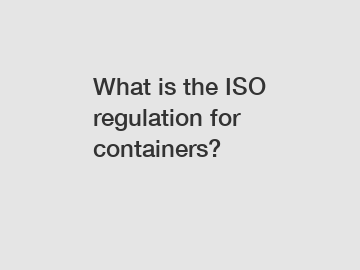What is the ISO regulation for containers?
What is the ISO regulation for containers?
The ISO (International Organization for Standardization) regulation for containers is a set of international standards that establishes the specifications for the safe transportation of goods in shipping containers. These standards, commonly known as ISO container standards or ISO container regulations, ensure the compatibility and integrity of containers used for intermodal transportation by road, rail, and sea.
The ISO container regulation was first introduced in 1961 when the ISO developed the standard sizes for shipping containers. This standardization revolutionized the shipping industry by allowing for efficient handling of goods across different modes of transportation and simplifying logistics processes. The most commonly used ISO container sizes are the 20-foot and 40-foot containers, known as TEUs (Twenty-foot Equivalent Units) and FEUs (Forty-foot Equivalent Units), respectively.

The ISO container regulations cover various aspects, including dimensions, strength, materials, markings, and testing requirements. These standards ensure that containers are robust enough to withstand the rigors of transportation and protect the goods they carry from damage or contamination. For example, ISO container regulations specify the maximum gross weight a container can carry, the minimum floor load capacity, and the maximum stacking weight, among other requirements.
Additionally, the ISO container regulations include guidelines for the design and construction of container corners and fittings. These guidelines ensure that containers are compatible with different handling and lifting equipment used across the globe, such as cranes, forklifts, and container ships' gantry cranes. This standardization facilitates the seamless transfer of goods between different modes of transportation and significantly reduces loading and unloading times.
Moreover, ISO container regulations mandate the proper labeling and marking of containers, providing essential information to the parties involved in the transportation process. Markings include the container's owner/operator code, unique serial number, maximum gross weight, and other identification details. These markings improve container traceability and enable easy identification during customs inspections and logistical operations, enhancing supply chain security and efficiency.
The ISO container regulations have had a profound impact on global trade and logistics. By providing a universal framework for container transportation, these standards have facilitated the growth of international trade, enabling businesses to reach global markets more efficiently. The standardization of container sizes has also led to significant cost savings and increased operational efficiency in the transportation and logistics industries.
Furthermore, the ISO container regulations have improved safety by ensuring that containers meet certain strength and structural requirements. This minimizes the risk of accidents, such as container collapses, during handling and transportation. ISO container standards have been widely adopted by industries across the world, giving confidence to shippers, carriers, and port authorities that containers meet internationally recognized safety and quality standards.
In conclusion, the ISO regulation for containers establishes the standard specifications for safe and efficient transportation of goods in shipping containers. These regulations have transformed the logistics industry by simplifying intermodal transportation, improving safety, and enhancing supply chain efficiency. The adherence to ISO container standards ensures compatibility, integrity, and traceability of containers, benefiting businesses and economies globally.
If you are looking for more details, kindly visit CNG Storage Equipment, industrial Gas Transportation Equipment supplier, marine lng tank.



Comments
0